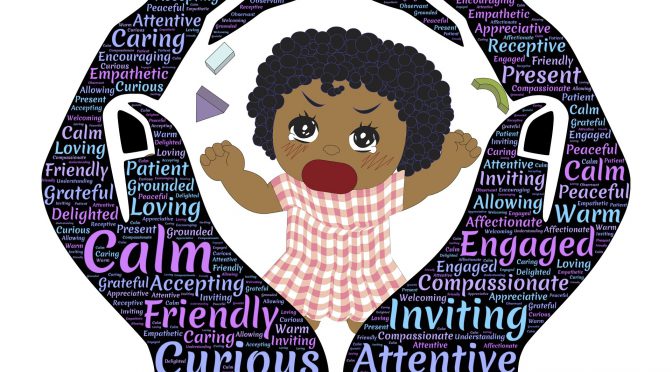By Kelly Bartlett, author of Encouraging Words For Kids, certified positive discipline educator and Attachment Parenting International Leader (API of Portland, Oregon, USA), www.kellybartlett.net. Originally published in the “Feeding Our Children” 2009 issue of Attached Family.

“Beep! Beep! Beep! Oh, bread’s ready!”
This was my 24-month-old son “cooking” as he took his bath. With only one tiny ceramic cup in the tub with him, he found a way to entertain himself, and I was listening to his running commentary.
“OK, got some water. Now add the flour. Stir. Got some yeast. Sprinkle it. Mix it, mix it, mix it ’til it’s yummy.”
He was adding “ingredients” and stirring the contents of his cup. He turned and placed his cup of “dough” under a washcloth on the side of the tub; this was the oven. After a few seconds, his “timer” beeped and the bread was ready. He took it out of the oven and presented me with his freshly made bread saying, “Hot, Mama, hot! You need to cool it, so don’t eat it yet!”
This is not the first time that either of my kids have “baked” with water, sand, dirt, leaves or other yard debris, but it was the first time that I took pause for a moment and marveled at my barely-2- year-old’s understanding of food. It wasn’t so much that he knew the ingredients or the process of making bread, but really I was proud that moments like these exemplify my kids’ understanding that food doesn’t come from a box or plastic bag. It comes from elements of nature. It comes from someone’s time and effort. It comes from worthy ingredients combined with love.
A Natural Progression from Breastfeeding
Oh, the love that goes into my cooking and baking! Years ago, when we were introducing our 6-month-old daughter to solid foods, I considered the breastmilk she had been receiving full time up until then. It was nutritious, natural, had no preservatives and contained no artificial ingredients or colors. It was everything she needed, nothing she didn’t, and was always prepared and served with the utmost love. I wanted her “fine dining” experience to continue and began to consider more carefully the foods that we introduced.
When I glanced down at the ingredients on my tiny container of yogurt and read high fructose corn syrup, carrageenan, red dye #40, and 30-plus grams of sugar, I wondered if something like that was the best choice of foods to allow her to ingest. No, I decided, we can do better than this. Thus began our journey of whole-foods eating, which has given us so much more than a healthier diet.
I say “us,” because I figured that if there were healthier options to feed our baby girl, why shouldn’t I incorporate them into my husband’s and my diet, as well? I knew that a lot of positive parenting comes from leading by example, and this would include eating habits, too. Moreover, just like Attachment Parenting, the most nourishing cooking happens when it’s created from scratch—nobody else’s prefabricated recipe, no superficial packaging, just the basic ingredients required to meet everyone’s needs.
Whole Foods Now a Lifestyle
Many years after adopting a clean and simple approach to eating, our lives are subtly but greatly enriched through the foods we choose to eat. It’s the effort in getting those foods and the experiences we share in doing so that adds an aspect of closeness to our lives. Because we cook from scratch, our goal is: If we want to eat it, we have to make it. This includes fun challenges such as marshmallows, butterscotch pudding, and chips and salsa.
Our adventures in obtaining ingredients include going to farmers’ markets, heading to the flour mill (and marveling at the huge stone mill), getting to know our milkman, quests in picking all kinds of Oregon berries, trips to various farms for fresh eggs and nuts, and many informative discussions about where meat comes from.
Together, our family has found our own rhythm for meal times. Breakfasts and lunches are just for the kids and me, and my husband joins us after work for dinner. We start our days with a hearty combination of whole grain and protein, like whole wheat waffles and yogurt or homemade granola bars and scrambled eggs.
Breakfast is also when we get our bread started for the day. Four ingredients into the bread machine, hit the start button, and it’ll be ready for lunch.
Lunch goes in phases, beginning with a protein plate that the kids share while they’re still in the midst of their morning play. We are omnivores, but usually eat vegetarian for breakfast and lunch as it helps curb the expense of organic meat. So, the kids will grab bites of beans, nuts, tofu or cheese while they finish their work. Because they are hungry and they choose the proteins for lunch, the plate usually empties.
Then we all sit down at the table for fruit, vegetables, dip and beverage. I’ve seen both kids eat raw vegetables, with or without dip, that they would not eat if they were cooked. By the time we’re done with the “vitamin and fiber” phases, the bread machine is finished. At this point, the kids are satisfied with about half as much bread as if it were served at the beginning of lunch, and they’ve consumed a more balanced meal overall.
Of course, some days we scrap it all, and have macaroni and cheese instead (made from scratch)!
The Family Part of Eating
Our dinner rhythm varies each day, but it always includes sitting down and eating together as a family. Depending on what our activities are for the day, I might have dinner already in the slow cooker, I might quickly put together a pasta dish or I might have time to invite my kids to cook with me. But we always come together at the end of the day for this important meal.
This coming together is the most vital ingredient. Having dinner together is like an automatic family meeting every night!
Sometimes my husband asks everyone, “So, what was the best thing that happened to you today?” Or sometimes my daughter makes statements about what’s on her mind like, “I want to talk about how plants grow.” Even my 2-year-old gets into the conversation and shares what’s been occupying his thoughts lately.
This ritual of eating together not only allows us time to share what’s on our minds and connect with each other but also is yet another way for our children to cultivate their trust in us. They know that every day they will unquestioningly get the sustenance they need: physical nourishment and emotional connection.
Adding Positive Eating Habits in Your Home
I know it must sound like we spend our entire lives focused on obtaining, preparing and eating food! You must wonder, do we have time for anything else? And with all of our busy lives, who would want to spend this much time in the kitchen? Is it possible to adapt some whole-foods, secure-attachment-promoting techniques regarding eating habits, yet not spend so much time in the kitchen?
Here are tips for adding positive eating habits into your meal routine:
· Start small. Make one change at a time and allow your routine time to adjust.
· Choose one commercially made/prepackaged product that you regularly buy, and replace it with a homemade or homegrown version. It could be anything from frozen burritos to chocolate syrup!
· Choose one meal for which you sit down together regularly as a family at least one day a week. Start increasing this as often as you can.
· If you have a bread machine, dust it off and try it out!
· Find one food that you can start buying locally. Take your kids with you.
· Whenever you prepare your child’s favorite dish, give him a task in helping prepare it. Take a photograph of him with his work.
We spend a lot of time in the kitchen because we like it. I enjoy cooking and baking, and my kids love eating. So, we’re very comfortable spending an afternoon together chopping, mixing, talking and snacking.
I do enjoy our trips to local farms and markets to buy the fresh ingredients we need, but they could easily be found in a grocery store. Even large grocery store chains are stocking more and more organic and locally grown products. Sometimes when we just don’t have the opportunity to turn shopping into a daylong family bonding experience, I will go to an online grocery store and have frozen (unsweetened) fruits, pre-cut vegetables and a supply of basic pantry ingredients delivered to my door.
Despite the occasional requirement for modern convenience, I do treasure the time that my kids and I spend making our meals together, and I try to provide that opportunity as often as I can. This time in the kitchen can be spent in a number of ways, depending on what my kids need. They might need to be physically close to me—being in another room, or even across the room, might not be in the cards that day. They might need something to keep their hands busy, an opportunity for “real” work. I love satisfying this need, because I can see the pride on their faces as they do meaningful, independent work.
They might need to experiment and analyze, to satisfy their innate curiosity by learning about mixing, pouring, textures, scents, machines and general cause-and-effect. They might need to work together–cooperating by adding ingredients to the dough and problem solving when only half an egg makes it into the bowl (scraping it off the counter works just fine for them). They might need to talk—to tell me things, small things, which help me understand them better, like: “Mom? All I like to do is read books and forget about stuff.” This time in the kitchen feels so worthwhile.
Through fresh ingredients, working together in the kitchen and sitting down for regular family meals, I am giving so many things to my children. The most important of which, and the reason why I continue to put so much effort into our meals, is that it brings us closer together. Like breastfeeding, a made-from-scratch approach to family meals incorporates physical closeness, uninterrupted time together, emotional connection, high-quality nutrition and family security.
I hope that one day my children will look back on our time in the kitchen with fond memories, as I know that right now they cannot articulate all that is going on before, during and after our mealtimes. Mostly what they take away from our dining experiences are feelings of security and love. They feel the love that goes into our meals, and they instinctively know that they are worth it—worth the time, planning, expense and effort of whole-foods preparation.
The Importance of the Family Table
Coming together to eat as a family is an essential way for many families in today’s fast-paced world to slow down and take time to connect with one another. This is important not only for the parent-child attachment relationship but also for the child’s future. Here is some recent research showing how the family table can benefit your child:
· Children who partake in family meals have smoother and faster cognitive and behavioral development, because they observe and learn from their parents in communication, morality and other areas of social skills, according to a study by the Dyscovery Centre at Newport University (Wales).
· Teens who regularly take part in family activities, including eating together, are less likely to have sex, according to a study by Boston College (USA).
· Teen girls who regularly eat meals with their families are less likely to smoke, drink alcohol and use drugs, according to a study by the University of Minnesota (USA).
· Children of families who eat together consume more fruits, vegetables, calcium-rich foods, vitamins and minerals, and eat less junk food, according to a study by the University of Minnesota (USA).
· Children of mothers who think eating together as a family is important are less likely to struggle with obesity as adolescents, according to a study by the University of Queensland (Australia).
· Teens who regularly eat meals with their families are less likely to engage in alcohol and substance use, according to a study by the National Center on Addiction and Substance Abuse (USA). Eating together reduces tension in families and leads to more teens saying their parents are proud of them and that they can confide in their parents about a serious problem.
· A paper by researchers at Washington State University (USA) discusses how family meals improve relationship-building communication and contribute to better school performance, better language development among preschoolers and more well-adjusted adolescents. As teens, these children were less likely to use drugs or be depressed and were more motivated at school and had better relationships. Families who eat together are also more likely to eat nutritious foods. The paper also found instances when family meals are harmful: when children are forced to sit face-to-face with controlling or dysfunctional parents, such as those who dominate the conversation, bring up hostilities and suppress children’s opinions. These parents are also more likely to use food as a tool for punishment or manipulation, such as offering food as emotional comfort.
You might also enjoy the other articles in our National Nutrition Month series:
Kids in the Kitchen: An Interview with Sally Sampson, Founder of ChopChopKids
Feeding the Whole Family: An Interview with Cynthia Lair of Cookus Interruptus
Malnourished by a Western Diet, or NDD by Dr. William Sears










